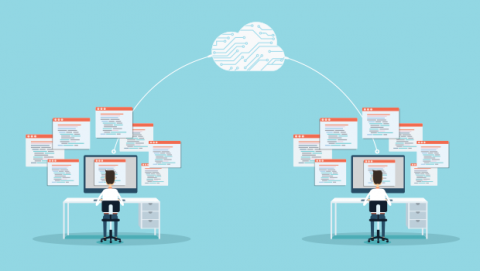It’s been almost 11 years since Marc Andreessen famously posted, “Software is eating the world.” Over the last decade in IT, we’ve seen some amazing transformations happen – from companies fundamentally changing the way they deliver software to how we as consumers use web and mobile applications and services in our daily lives. Research shows that the average person in the U.S. now uses at least four to five software programs a day to do their job – partially due to the pandemic.
Developing software has emerged as perhaps the most critical business function for companies as they undergo digital transformation to adapt to fast-paced change, delight their customers, and stand out from competitors. As such, the role of software developers has evolved at such a rapid pace that it is now more common to deliver software updates and new features daily than weekly or monthly.
[ Also read Software development in 2022: 5 realities CIOs should know. ]
Additionally, emerging technologies in artificial intelligence, machine learning, cloud-native computing, and more are pushing the bounds of possibilities for software development. Developers require time to learn and develop new skills to use or create systems from these emerging technologies. However, as technology becomes more sophisticated and the developer role continues to evolve, technology solutions can help augment what can be a steep learning curve for developers – Cloud AI Developer Services.
3 questions about Cloud AI Developer Services answered
Let’s explore how the role of developers is evolving due to the use of these technologies.
What are Cloud AI Developer Services?
Gartner defines Cloud AI Developer Services (CAIDS) as “cloud-hosted or containerized services/models that allow development teams and business users to leverage artificial intelligence (AI) models via APIs, software development kits (SDKs), or applications without requiring deep data science expertise."
In other words, developers don’t need extensive background knowledge or experience in using AI and Machine Learning (ML) to be able to leverage these systems for developing new data-intensive or science-based applications.
How do developers use Cloud AI Developer Services?
With CAIDS, developers can use AI/ML models to help group sets of information, conduct trends analysis, undergo risk assessments, automate data aggregation, and perform other processes. The intended outcome is to help developers use these data models to add new application functionality or automate manual or mundane processes to enhance products or services. Additionally, developers can leverage the use of AI/ML models to create next-generation applications in the form of:
- Building new ML models to improve the productivity of teams or systems, such as suggesting the next best actions in a process or timeline, forecasting the probability of a user to purchase, or automating decision-making for business workflows.
- Conversational agents or dialogue systems that can conduct natural language processing and also provide automatic responses using human languages.
- Adding (or extracting) metadata to unstructured text or images, and more
How do Cloud AI Developer Services change a developer's role?
CAIDS are meant to help developers expand their expertise and function within a team. Helping to lessen the learning curve of implementing technologies like AI/ML is one benefit, but it also serves developers in several key areas of productivity and helps them concentrate on more complex tasks or by delivering more value to the business by building next-gen software faster.
Increasing the speed and scalability of development
The development of AI and ML can help shorten development time and cycles. For example, automated machine learning services can provide developers with automated tools that can help facilitate data preparation, feature engineering, or even data science modeling. Developers can now deploy, monitor, and manage AI/ML models without having to become data science experts.
Helping the business engage with customers frequently
Consumers expect companies to respond to them quickly. If your organization isn’t developing new ways to stay digitally connected with its end-users, it is likely to lose to one that is. Embracing AI-assisted customer support tools and technology is going to be key for the future of any business, as messaging apps and services provide a direct and immediate touchpoint for the customer.
Development teams will increasingly be called upon to build and incorporate language services in websites and applications with AI/ML models included, to enable gratifying and immediate customer service. Developers can create conversational agent frameworks that can understand and respond to natural language or analyze text to better understand customer sentiment and challenges.
Turning visual analytics into powerful use cases
An emerging field of AI/ML is computer vision, which can enable computers to derive information from imagery, video content, and other visual inputs. Cloud AI Developer Services help developers write new applications to incorporate next-gen functionality for image recognition, video content analysis, and optical character recognition (OCR).
For example, surveillance cameras can now incorporate object detection and facial recognition from AI to help the system understand what is happening in real-time from another location and actively alert the system if necessary.
Another example is data entry. The world is going paperless and contactless, and these services can provide a method for digitizing printed text. This would enable paper text to be electronically edited, searched, stored, displayed, and/or used in other machine processes like text-to-speech.
Final thoughts
Developers’ roles are evolving frequently within organizations, particularly to help support or transform the various enterprise IT systems or to bring new, exciting software to market. AI/ML is already starting to augment certain development functions in the form of automating tasks, helping to author code, and much more.
However, developers will never become obsolete. As software development gets increasingly complex, we will need the power of the human brain to give it direction and purpose.
Join DevOps Institute on June 30 for SKILup Day: Cloud and AI to learn more about CAIDS and how these services and models can help you develop intelligent applications without requiring deep data science experience. Register here: https://www.skilupdays.io/ai-22.




